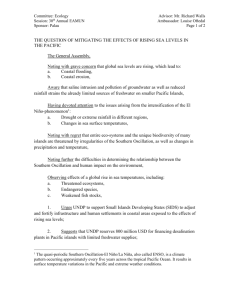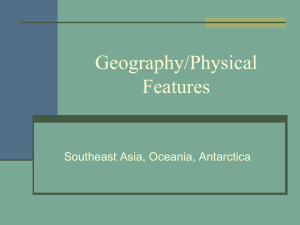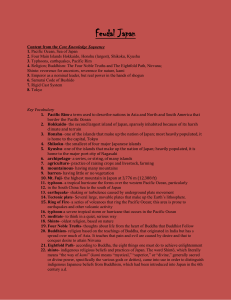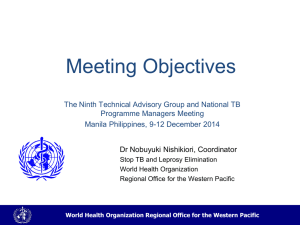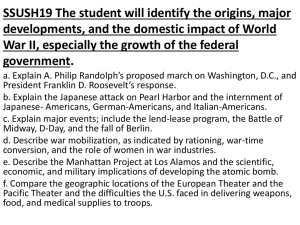FinalDraftIFSHeadnoteJohnBrosky
advertisement
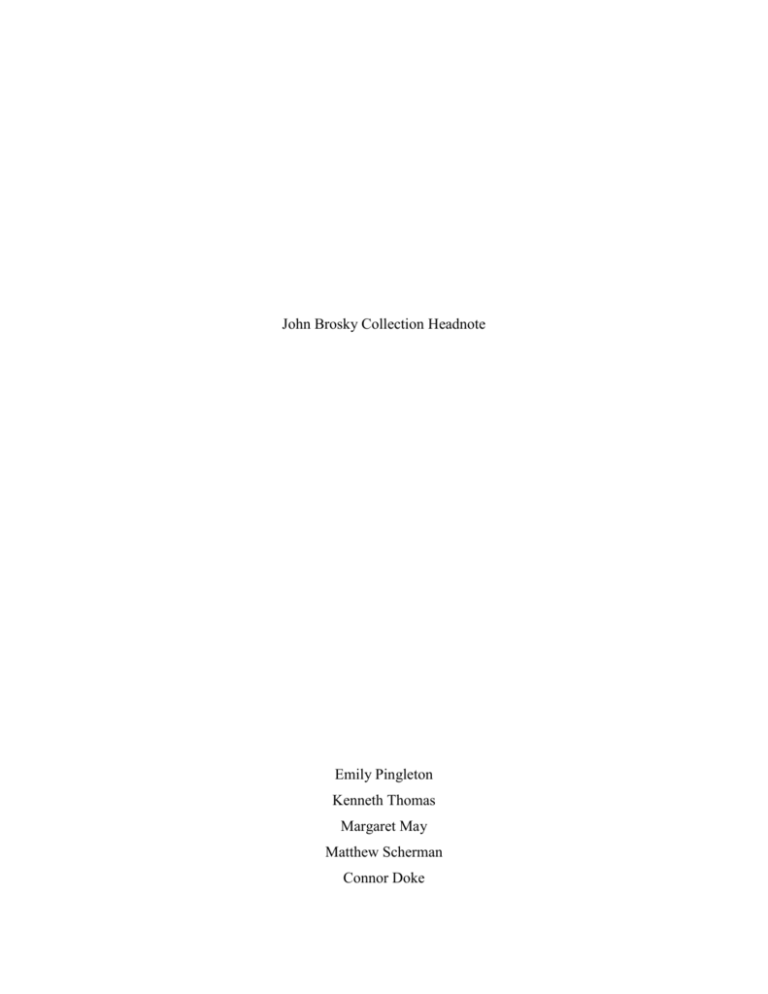
John Brosky Collection Headnote Emily Pingleton Kenneth Thomas Margaret May Matthew Scherman Connor Doke 2 The John G. Brosky Collection was donated to Florida State University by John Brosky after finding the letters in his sister’s attic following her death. Six boxes make up the John G. Brosky Collection; nearly the entire collection is comprised of handwritten correspondences between Brosky and his immediate family. These letters provide a great insight into the life of an American combatant serving in the Pacific Theater during World War II. John Brosky primarily wrote to family members and close friends; the most frequent correspondence occurred between John Brosky and his mother, Rose. In the letters to his mother, John wrote about “staying cheerful” and his safety during the war. The mention of his great distance behind battle lines may have just been comforting lies to a concerned mother; however, in Brosky’s case, it was mostly true due to the fact that he worked on islands already controlled by the Allied forces. Other notable correspondents with Brosky include his father, Joseph; brothers, Stan, George and Vern; and sisters, Ann and Bertha. John G. Brosky was born in Scott, Pennsylvania in 1920. As the son of Joseph and Rose Brosky and one of seven children, John Brosky grew up in a modest family during the Great Depression. He attended Clark High School, located in Allegheny County, and excelled in athletics, eventually earning a football scholarship to the University of Pittsburgh. Brosky also served as captain of the cross-country team while earning his bachelor’s degree. John Brosky participated in the ROTC program at Fort Monroe, Virginia in 1941, serving as the leading Battery Commander. Following his graduation in 1942, Brosky was drafted and continued his training at the Lt. Coast Artillery School in Fort Monroe, Virginia. Training consisted of instruction and shooting 3 practice at the pistol range. Consistently hitting a majority of the stationary and moving targets, Brosky was one of the better marksman. He soon transferred to Fort Mason in California to prepare for transport to the South Pacific. Brosky continued training in the South Pacific by leading target practice with large coastal artillery guns and teaching unarmed combat. The duties of a coastal artillery unit consisted of taking care of the guns and practicing their marksmanship with ocean targets. Brosky mentions this process in one of his letters dated January, 1943. Brosky and the 276th CA Battalion, his coastal artillery unit, began their World War II service in Bora Bora on December 17, 1942 as a part of Harbor Defense in the South Pacific. Brosky and his Coastal Artillery unit were essentially sent to islands captured from the Japanese. As acting Battery Captain of artillery, Brosky was in charge of a group of men who fired the 155mm artillery gun, using both the US 155mm Howitzer M41 and the US 155mm Gun Motor Carriage M12. These two guns were developed by the United States military to replace an out of date artillery weapon called the M1918.1 The United States used the M1918 primarily for harbor defense, which was an integral part of the Cartwheel Operation that defeated the Japanese in the Pacific Theater. This operation made sure that the American campaign in the Pacific Theater would begin in the South Pacific Islands, securing the shipping lanes and communication lines to and from the mainland United States and the strong ally of Australia. This ensured that the United States would not be caught without proper resources down the line and be able to secure the safety of Australia. The main objective of this campaign was to gain control of Rabaul, which was a large stronghold for the Japanese in the South Pacific located on the island of New Britain near New Guinea.2 As a part of the harbor 4 defense, the coastal artillery units, like Brosky’s unit, were essential in keeping control of the waterways in and around these islands. From Bora Bora, his unit travelled to New Hebrides, New Georgia, New Guinea, and the Philippines, travelling by ship each time they moved. Their location in August of 1945 was at Oro Bay in New Guinea.3 While stationed on the various islands throughout the South Pacific, Brosky not only fought a war against the Japanese, but also a battle with the elements. Rain was a constant threat to the morale of the soldiers and continually plagued those who served on the islands of the South Pacific. John Brosky wrote in his letters that the “rain hit us [his battery] about 0730 this morning and hasn’t stopped yet.”4 Brosky’s encounter with the torrential rain was a common experience for many G.I’s in the South Pacific. In Touched with Fire: The Land War in the South Pacific by Eric Bergerud, there are accounts by soldiers about the conditions on the island of Bougainville about the “200 inches a year.”5 The challenge of surviving the elements added to the emotional turmoil of combat with a formidable enemy; this struggle was a large part of the soldier’s life in the South Pacific Theater of World War II. Another soldier in Bergerud’s book mentioned that the average soldier would feel “very unclean, which made [them] unhappy with [themselves].”6 This reiterates the intense effect that the environment had on the soldiers and their experiences during the war. Another natural phenomena, which pestered the combatants, were the swarms of mosquitos. John Brosky mentions them in letters and how he went “whacky” from all the “mosquitos” which swarmed around their campgrounds and compound nightly.7 One combatant mentioned how the “mosquitos were so thick you could wipe them off your arms in handfuls.”8 The numerous insects combined with the rain increased the combatants’ degree of frustration when dealing with their surroundings during battle 5 in the South Pacific. Another aspect of the elements that affected combatants was the heat. Brosky mentioned how most of the men had a “heat rash” from the extreme heat and lengths of time that they were exposed to the sun every day.9 Combatants compared the heat they experienced to the “first degree of insanity.”10 Soldiers trained in Hawaii talked about how their intense training there better prepared them for the heat conditions that they encountered in the South Pacific.11 The natural conditions of the South Pacific Theater were unique compared to the conditions of the European Theater, in that the islands were new frontier to many people from the developed world and it played a large part in the personal struggles and military strategies of the armies of the Allies and the Japanese. The daily life during World War II for John Brosky was filled with the regular duties of a serviceman in the South Pacific and the unique stories which Brosky chronicled in his many letters. Brosky continually wrote the news in his “Palm Day Journal” which he posted on the camp’s news board every week. This and his leading of “Jungle Church” are just some of the examples of how Brosky took leadership and camaraderie with his unit seriously. Fortunately, for Brosky and his unit, they primarily worked on islands already controlled by the Allied Forces, avoiding heavy combat zones. Rather than spending numerous days hunkered down in foxholes, Brosky was able to spend his time exploring the beautiful islands of the South Pacific. Multiple times throughout his letters, Brosky mentioned adventuring through jungles, swimming in the crystal clear ocean, playing baseball and volleyball, and relaxing on the beach. On January 2, 1945, he wrote: “The weather was good most of the days, so, we lounged around on deck, sun tanning, reading 6 books, and playing cards.”12 Writing letters, listening to news, setting up camp, taking pictures, and dating WACs also filled up much of Brosky’s daily activities Religion was a very important aspect of Brosky’s life. As a devout Roman Catholic, Brosky attended daily mass and received Holy Communion on a regular basis. He often referred to the liturgy as “Jungle Church,” which was led by a military chaplain. On March 4, 1945, Brosky wrote: “Unlike back home, the fellows look forward to going to church, as it sets off Sunday from the rest of the week.”13 Brosky also mentioned going to confession and Benediction on Christmas Day. Captain John G. Brosky’s tour of action was cut short when he was afflicted with malaria. Upon returning to America, Brosky took advantage of the Servicemen’s Readjustment of 1944, popularly known as the G.I. Bill, to enroll in the University of Pittsburgh’s law school. He received his degree of J.D. in law in 1949. In 1950, Brosky married his wife Rose and together they had three children: John, Carol, and David. Shortly after graduation, Brosky enlisted in the Pennsylvania Air National Guard, in which he achieved the rank of major general upon retirement and remained involved in military affairs until his death. His most notable achievement was his prevention of the 911th Airlift Wing, an Air Mobility Command unit of the Air Force Reserve, from closure twice. In addition to the National Guard, John Brosky was also the national president of the Air Force Association. Brosky used his law degree to serve as a judge in Pennsylvania, where he spent more than two decades in the county courts until his election to the state’s Superior Court. He spent nine years in the Supreme Court until he decided not to run for re-election in 1989. Judge Brosky finally retired in 2002, after spending the final thirteen years of his judicial career as a Senior Judge. John G. Brosky 7 died on October 10, 2010 at the age of 90 after battling pneumonia and heart problems. The letters written to and from John Brosky during the Second World War document a unique soldier’s experience in the Pacific Theater. The John G. Brosky Collection, part of Florida State University’s Institute on World War II and The Human Experience, comprises only a very small portion of the Institute. The Brosky Collection, along with the other countless letters of American G.I. of World War II, preserves the stories of a generation that will never be forgotten. 8 Notes 1. John Batchelor and Ian Hogg, Artillery, (New York: Von Hoffmann Press, Inc., 1972), 112,114. 2. John Miller, Jr., The War in the Pacific: Cartwheel: The Reduction of Rabaul, (Washington D.C.: Office of the Chief of Military History Department of the Army, 1959), 1-7. 3. Shelby L Stanton, Order of Battle: U.S. Army, World War II, (New York: Presidio Press, 1984), 493 4. John Brosky to Bertha Brosky, 26 January 1944. John Brosky Papers, Coll. #02.0300, The Institute on World War II and the Human Experience, Florida State University, Tallahassee, FL. Edited the quote for contextual purposes. 5. Eric Bergerud, Touched with Fire: The Land War in the South Pacific, (New York, New York: Penguin Group, 1996), 66. “They tell me that Bougainville is the rainiest place in the tropics. I know that they get over 200 inches a year. We must have got over 150 of it the first week we were there.” 6. Bergerud, Touched with Fire, 63. “You were very unclean, which made you unhappy with yourself. It was degrading. I saw much combat, but the personal filth is one of my most unpleasant memories of the war.” Quote edited the quote for contextual purposes. 7. John Brosky to Family, 2 January, 1944. John Brosky Papers, Coll. #02.0300, The Institute on World War II and the Human Experience, Florida State University, Tallahassee, FL. 8. Bergerud, Touched with Fire,70. “Mosquitoes were so thick you could wipe them off your arm in handfuls.” 9. John Brosky to Family, 2 January, 1944. John Brosky Papers, Coll. #02.0300, The Institute on World War II and the Human Experience, Florida State University, Tallahassee, FL. 10. Bergerud, Touched with Fire, 63. “The heat and flies were so bad that they almost drove us to the first degree of insanity.” 11. Ibid. “I would never had made except for the tough training I had in Hawaii.” 9 12. John Brosky to Family, 2 January, 1945. John Brosky Papers, Coll. #02.0300, The Institute on World War II and the Human Experience, Florida State University, Tallahassee, FL. 13. John Brosky to Family, 4 March, 1945. John Brosky Papers, Coll. #02.0300, The Institute on World War II and the Human Experience, Florida State University, Tallahassee, FL.
